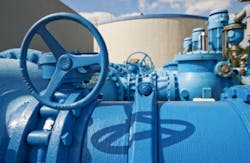Common centrifugal pumps in water services have been horizontal single stage pumps; often the most popular is the end-suction, top-discharge one. Other types of pumps, such as multistage pumps, vertical pumps, etc., have also been used in applications and services based on specific requirements.
Pump design and components
Pump casings should be centerline supported if pumping temperature exceeds certain levels. The top discharge and centerline supported pump design provides excellent stability when subjected to piping forces (nozzle loads) or extreme temperatures.
Casing and impeller wear rings are usually provided at both sides of an impeller. These rings allow a small clearance to be maintained between components, and proper selection of these rings (material, design, etc.) need attention for good performance and reliability of a pump. Wear, corrosion, erosion and other degradation mechanisms could affect these components and enlarge clearances. Rings should be replaced if clearances are increased since large clearances can deteriorate hydraulic performance and pump operation. This is particularly important for radial-type, relatively high-head pumps (known as pumps with low specific speed) rather than mixed-flow pumps (or generally pumps with high specific speed).
In low-specific-speed pumps, which are usually low-capacity, high-head pumps, excessive clearances result in more power wastes than high-specific-speed pumps. For instance, in a centrifugal pump with low specific speed the required power is six percent increased where running clearances have been doubled. In other words, the performance of high-specific-speed pumps might theoretically be less affected by worn clearances. Excessive clearances can also affect the reliability of a pump. Worn clearances can cause high vibration, pump overheating, bearing failure, seal issues and even rotor instability.
Pumps with constant speed drivers should be capable of a certain level of increase in head at rated flow by a change in the pump system — for instance, installing a new impeller or (a different) diffuser. As an indication, such an increase could be at least five percent, whereas in many pumps possibilities for 10 percent or more increase in head at rated flow have been provided to deal with any reasonable changes, potential modifications or unexpected issues.
Severe operating conditions in many water applications have subjected pumps to corrosion, abrasion and other publishing operational factors. All of these circumstances have resulted in pump problems, particularly bearing and seal failures.
Bearings are critical components in pumps, particularly rolling-element bearings, which have been extensively used in small and medium pumps and could be subjected to different types of failures. Lack of hydraulic balance can overload thrust bearings, potentially resulting in thrust bearing failure in a short time. Usually all operating conditions, such as operating at degraded stage or off-design situations, are not considered in a pump’s design, and it is common to find bearings of a pump subjected to loads two or three times the design loads — bearing life is reduced eight to 20 times as a result.
Pumps with lubricated bearings are usually considered more reliable rather than those using grease. They are more popular for many services, including important water services — particularly any services or applications where an unscheduled shutdown is not acceptable, especially for medium or large pumps. The temperature of lubrication oil should be properly controlled and monitored at all stages and important points. As a rough indication, bearing oil return temperatures should not exceed 80° C based on rated operating conditions for commonly used lubrication oils.
Nowadays, mechanical seals are specified for nearly any pump (that needs seals), and other options (such as packing, etc.) seem very out of date. Of course there have been seal-less pumps. Cartridge-type mechanical seals mounted on hook-type shaft sleeves are most often preferred. High-speed pumps — e.g., pumps operating around or above 3,600 rpm — with tandem mechanical seals should often be equipped with a pumping ring in the secondary seal.
The mechanical seals need special attention for their selection, assembly, installation and commissioning. Seals should be checked for leakage, particularly during the first hours of operation. A minor leak through the seal usually stops after a short time, but if it continues there could be a serious issue. As another important indication, if there is something wrong with the seal installation, the seal can fail or become damaged in the first hours (or first day) of operation. Otherwise, it might be concluded that the seal installation has been reasonably correct.
Pump performance
Pump characteristic curve is the head versus flow rate. There have been various types of curves for different centrifugal pumps; however, there are four different curve profiles as follows:
- Normal curves: Where head decreases as flow increases. A typical (normal) curve head decreases relatively fast as flow increases.
- Steep curves: Head decreases very rapidly as flow increases.
- Flat curves: Head decreases very slowly as flow increases.
- Drooping curves: Similar to the normal profile except at the low flow end where the head rises then drops as it gets to the shut-off head point.
The normal curve can be more or less steep. A steep curve can be desirable from a control point of view for some water applications since a small change in flow will result in a large pressure drop. The steepness of the curve depends on many details, such as the number of vanes and the specific speed.
A flat curve is sometimes desirable for specific applications — for instance, where a change in flow only causes a small change in head. In some applications as more water customers in the discharge side are turned on, the head will tend to decrease. However because the curve is flat, the head will decrease by only a small amount, which means the pressure will drop only a small amount thereby keeping the water velocity high at the discharge.
The drooping curve shape should be avoided because it is possible for the pump to settle between two operating points that both satisfy the head requirement of the system. This is known to happen when two pumps are in parallel. When the second pump is started it may fail to get to the operating point or decide between two points that are at equal head.
Pump rotordynamics
Critical speeds should not encroach upon the operating speed range. Most pumps are stiff-shaft pumps with the first critical speed above 120 percent of the maximum operating speed. For variable speed pumps, the first critical speed should be above 130 percent of the maximum operating speed. Some large pumps might use flexible shaft designs. In those cases, the first critical speed is usually selected around 55 to 70 percent of the operating speed. Since higher limits (say above 70 percent) would be too close to the operating speed and lower ones (below 55 percent) might be too close to "one-half times speed," some issues could arise. The second critical speed is usually above 130 percent of the maximum operating speed. As a very rough indication, unfiltered vibration velocity, when measured radially to the shaft with a bearing-cap mounted vibration sensor, should often not exceed four millimeters per second peak to peak.
Shop test
Shop performance test is an important topic for nearly any pump. Pump manufacturers should operate each pump in the shop for a sufficient period to maintain at least six points of complete test data, including head, capacity and power. These six data points are subject to negotiation between different parties, but they usually include shut off, minimum continuous stable flow and midway between minimum and rated flows, 80 percent of rated flow, rated flow and 115 percent of rated flow.
Establishment of NPSHR presents far greater difficulty for a pump manufacturer than other performance parameters. Consequently when NPSHA is too close to NPSHR, an NPSHR testing should be specified. In other words, for pumps with marginal NPSH, a NPSHR testing is usually required. As an indication, NPSH margin less than two meters (or sometimes 1.5 meters) would result in NPSHR testing. The old-fashioned NPSH testing methods, such as by suction valve throttling, are not popular and a modern, more controlled NPSH testing method, such as a vacuum tank suppression test, is preferred.
Editor’s note: In next month’s part two, pump piping as well as site installation and operation will be discussed.
Amin Almasi is a rotating machine consultant in Australia. He is a chartered professional engineer of Engineers Australia (MIEAust CPEng – Mechanical) and IMechE (CEng MIMechE) in addition to a M.Sc. and B.Sc. in mechanical engineering and RPEQ (Registered Professional Engineer in Queensland). He specializes in rotating machines including compressors, gas turbines, steam turbines, engines, pumps, condition monitoring and reliability. Almasi is an active member of Engineers Australia, IMechE, ASME and SPE. He has authored more than 100 papers and articles dealing with rotating equipment, condition monitoring and reliability.


